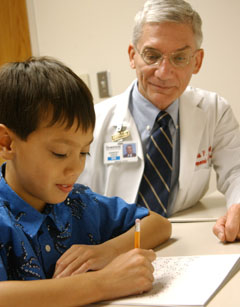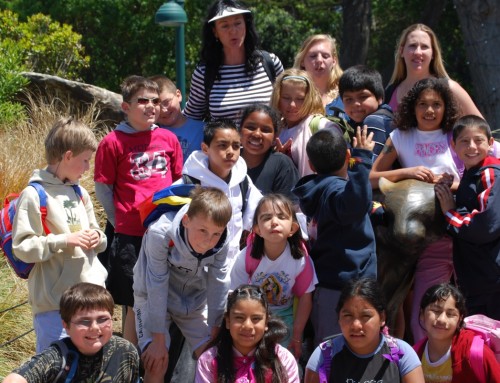Autism: understanding and setting expectations
One of the most important yet least understood areas of special needs parenting is the area of setting expectations. Here Enda and Val talk about some of their experiences getting the balance right.
For me the whole area of assessments, schools, special services, sports and expectations is an incredible conundrum. As Prof. Anne Sullivan once said to me ‘they are such little mysteries!’ referring to the many children she had worked with as clinical director of the Magnolia speech and language school. And that’s saying something because Anne is among the leading language development specialists in the U.S.
Assessments lead the way, right?
 In a perfect world, assessments should exist to diagnose your special needs child’s deficits and point the direction to a comprehensive intervention plan to fix what’s broken. Assessments should also demonstrate the effectiveness of the various services that work with your child and set out a road map for your child’s treatments over time. This is how modern medicine works right?
In a perfect world, assessments should exist to diagnose your special needs child’s deficits and point the direction to a comprehensive intervention plan to fix what’s broken. Assessments should also demonstrate the effectiveness of the various services that work with your child and set out a road map for your child’s treatments over time. This is how modern medicine works right?
I have spent some 30 years working in clinical research and this is how I was brought up in the medical world. When we designed a pacemaker, we knew exactly what was broken in the heart, how to fix the problem and how to measure the results afterwards. But when it comes to special needs children, children who develop differently from those termed ‘typical’, things are not that simple.
Our children are not broken in the traditional sense, rather they develop differently from what would be considered the norm. Sadly, these ‘learning differences’ frequently lead to speech and language delays or disorders, causing our children to be cut off from society. In the case of autistic children, a mix of language deficits and visual intelligence leads to all kinds of frustration, anxiety and behaviors that can be even more isolating than the core language deficit. Add to this sensory integration issues, possible deafness and other conditions frequently seen with autism and you have a real conundrum.
So while assessments have value in providing indications of where the issues lie, its still a real problem to sort between intellect, language disorder, sensory deficits, emotional and behavior problems to mention but a few. Still, the results do help in identifying what resources are needed to treat your child and justify their cost to the school district who are responsible to provide these resources. But after that, matters get quite foggy indeed.
Expectations for the unteachable.
 On one hand getting a diagnosis of autism with intellectual disability can be a ‘positive’ result in that it should justify lots of resources to help your child. On the other hand, it can cause chronically low expectations which can lead to negative self fulfilling outcomes. Conor, who is sitting beside me programming artificial intelligence into one of our technologies, had this problem in spades. Just see my post on school settings. The recommended interventions which surrounded his diagnosis assumed lifelong dependency with severe intellectual disabilities. Compounding this, the assessment frequently becomes substantially more authoritative than the opinions of parents and teachers who know and work with the child.
On one hand getting a diagnosis of autism with intellectual disability can be a ‘positive’ result in that it should justify lots of resources to help your child. On the other hand, it can cause chronically low expectations which can lead to negative self fulfilling outcomes. Conor, who is sitting beside me programming artificial intelligence into one of our technologies, had this problem in spades. Just see my post on school settings. The recommended interventions which surrounded his diagnosis assumed lifelong dependency with severe intellectual disabilities. Compounding this, the assessment frequently becomes substantially more authoritative than the opinions of parents and teachers who know and work with the child.
A case in point. During an assessment Eoin was asked what would he do in the case of a fire in our home. For reasons that are unclear he failed to respond and was for this question assessed as incapable. Around the same time, Conor and Eoin were playing with their Peter Pan pirate ship one Saturday
morning. I was upstairs vacuuming. With the finesse of a US seal team, the boys pried open a kitchen drawer, got the matches and set the boat on fire in the sink. What did the boys do? Eoin ran upstairs and dragged me down to the kitchen while Conor was trying to douse the fire with a glass of water. What was the result when we raised the question with the clinical team? Somewhere between A+ and absolute amazement!
Watching for the impossible
 Their are times I feel that with all the theories and jargon the big picture often gets missed. As parents we want our children to grow up happy and productive. To be as independent as possible doing the sort of things they like doing. And I stress things they like doing because we are all good at what we like. I call this the big picture. Their are many other terms for this like: start with the end in mind, get your ladder up against the right wall and so forth. What all this amounts to is getting a sense of where you want to end up and work back.
Their are times I feel that with all the theories and jargon the big picture often gets missed. As parents we want our children to grow up happy and productive. To be as independent as possible doing the sort of things they like doing. And I stress things they like doing because we are all good at what we like. I call this the big picture. Their are many other terms for this like: start with the end in mind, get your ladder up against the right wall and so forth. What all this amounts to is getting a sense of where you want to end up and work back.
So if our children are such conundrums how do we mere mortals figure out the big picture? We did this by active watching. What I mean is we got the boys involved in activities they gravitated to and watched how they responded. The boys seemed to be running all the time. They never walked anywhere and frequently looked like they wanted to be in 10 places at once. So it seemed reasonable that high movement / activity sports could be a way to go.
They loved music, so exposing the boys to CD players and subsequently Ipods resonated with us. We set the boys up to use the players but at the same time left plenty of scope for them to experiment. They loved Disney and Pixar movies so we got songs from their favorite movies. Would they be able to pick out their preferred music? Could they navigate the menus? Or would we find it all smashed at the bottom of the stairs?
Puzzles were always a hit in our house with both boys progressing to hundred piece renditions all over the dining room table. This led us onto all kinds of highly visual video games like WII, DS lite and subsequently computer based educational games. Especially animated, Pixar and Disney games. Why this direction? When the boys were 4 years old they got a hold of my work laptop. Conor figured out how to get into the operating system and wiped the hard drive. At that time, even I didn’t know how to do this.
But what the boys really loved, would kill for and would roll around the floor pretending to be was Woody and Buzz Light Year. I remember going out shopping one Saturday afternoon. These were generally nightmare scenarios for Val and I because you just couldn’t predict what they would do or go. Still nobody would baby sit them and going out was better than staying in. So we were in Target and drifted into the video and TV section. The next thing I saw was the boys rolling around on the floor fighting in peels of laughter. And what was on the screen, I mean every screen in the whole department? Woody and Buzz Light Year rolling around on the ground in the gas station scene. They were just 5 years old. And here was the unteachable and unreachable pretending to be a cartoon character. Pretending to be someone else at a time that the assessments strongly indicated their was no one in there to start with.
From the known to the unknown
 So there were all kinds of signals coming from the boys in the midst of a whole lot of confusion. Things you couldn’t hear because the boys were completely non-verbal. But they were their to be seen if you knew what to look for. And we started looking at all sorts of behaviors with fresh eyes. When I started out as a young engineer with Abbott in Chicago I worked with Robotics and artificial intelligence. I understood the nature of visual intelligence and communication. No matter what the assessments stated or predicted in terms of ability, I could see the boys were processing information visually and this was a major strength.
So there were all kinds of signals coming from the boys in the midst of a whole lot of confusion. Things you couldn’t hear because the boys were completely non-verbal. But they were their to be seen if you knew what to look for. And we started looking at all sorts of behaviors with fresh eyes. When I started out as a young engineer with Abbott in Chicago I worked with Robotics and artificial intelligence. I understood the nature of visual intelligence and communication. No matter what the assessments stated or predicted in terms of ability, I could see the boys were processing information visually and this was a major strength.
So we adopted one of the oldest educational maxims their is: go from the known to the unknown. What this means is what ever the boys demonstrated they could do, do more of it. And in the midst of all of this, the most important of all was that the boys were visual thinkers, responded to visual stimulus and were learning visually. There was a way in and we were not going to waste this insight. In many ways what we were seeing was very similar to what Maria Montessori had pioneered, what Temple Grandin related about her life, what Stanley Greenspan said about Floortime. Follow the child’s lead and he will take you where he needs to go. I’m not saying that the road that opened up in front of us was easy to travel, but for the first time since Val said ‘they’re not talking’, I felt there was a road to follow.
The insight was incredibly important because whenever we were confused by how to proceed, what placement was best for the boys, what sport they could do well in, how to grow their communication, just about anything relating to their development, we just ran with what they were good at. We surrounded ourselves with all kinds of people who shared our view of the boys’ and were willing to walk our boys journey, not the one suggested by the assessments alone.
Expectations matter: summary
 So what did we learn? Sure the boys had some serious issues and learning differences. OK, very serious issues. It wasn’t going to be easy. In many ways they were buried deep within themselves, cut off from us all in a traditional sense. But with patience and a watchful eye it was possible to see there was a lot ‘in there’. And by creating space around the boys, exposing them to activities that they clearly enjoyed and could learn visually, following their lead and driving their activities with high expectations, they amazed even Val and I.
So what did we learn? Sure the boys had some serious issues and learning differences. OK, very serious issues. It wasn’t going to be easy. In many ways they were buried deep within themselves, cut off from us all in a traditional sense. But with patience and a watchful eye it was possible to see there was a lot ‘in there’. And by creating space around the boys, exposing them to activities that they clearly enjoyed and could learn visually, following their lead and driving their activities with high expectations, they amazed even Val and I.
They were highly visual and could learn easily when ideas or activities were presented visually. From a presentation of profound physical and neurological disorder: unreachable and unteachable: they are now showing us not only what they can do, but rather what is possible for children like them around the world. Conor, the technical twin now programs complex language software and is leading its introduction into schools seeking to make a difference for our children. Eoin, the social one has immersed himself in liberal arts and the human condition. He too will follow a path to change the lives of children who are experiencing a life without communication much as he once did.
Without Val and I having the kind of expectations for and behalf of the boys, none of this would have happened. And our expectations were born of what the boys showed us. What was possible for them. So we followed their lead to bring them to where they are today. Success is infectious. Teachers, clinicians, society at large engage when they see a path forward and understand the possibilities. But make no mistake, only us, as parents and advocates, living and growing with our children, can lead and drive their development.
This is a point I can’t over emphasize. As I imagine you have gleamed by now, raising special needs children is not like anything you are likely to have done or even imagined in the past. With few exceptions their is always someone who can solve or fix problems in our lives. To show us the way in difficult times. But to take this view of the challenges presented by our unique children leads to every increasing problems as the road rises ahead of us. So in parenting of special needs children we must continue to lead and set expectations at least until society is willing to embrace the great gifts our children present to the world.







Leave A Comment